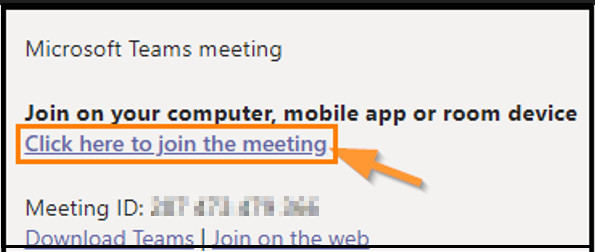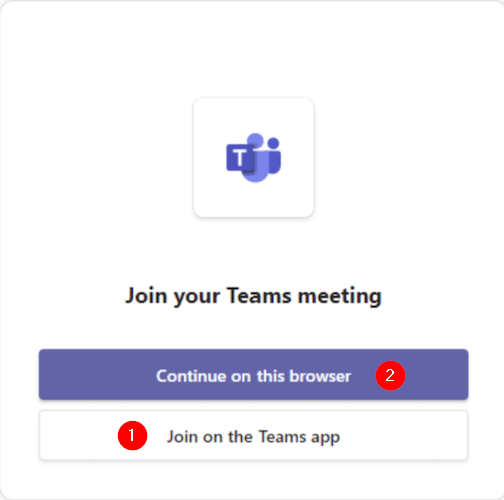Teams is a Microsoft communication tool used at Goucher for virtual class meetings or other video conferencing sessions. Teams is included in your Goucher Office 365 account, so it is available to every student to use for free while they are taking classes.
Installing the Teams Software
Microsoft Teams is included with Goucher Office 365 accounts and can be installed on PCs, Macs, and mobile devices, or used directly in a web browser.
-
- The Teams software or app* – Download Teams for work or school on your PC or Mac desktop, iOS, or Android.
*Recommended for the best experience
For Windows Desktop downloads choose “Teams for work or school”.

- Or A Web Browser – Go to https://teams.microsoft.com.
The browser client can also be used although it does have limitations when compared to using the installed client software or app above. Chrome or Edge are considered the best browsers for Teams Meetings. Make sure your browser has been updated to the latest version. For more information about supported browsers see Web clients for Microsoft Teams.
Logging into Teams
Log into your Goucher Teams account using the same format used to log into your email and other Office 365 software – username@goucher.edu (NOT firstname.lastname) and your Goucher password. You can double-check that you are logged in by clicking the profile picture in the top right corner.
Note for Windows Users: If you already have a TEAMS account with another organization, you can select “add account” on the log in screen to add your Goucher account. Click here to see more information on managing multiple accounts in Teams. This feature is only available to users who have upgraded to “New Teams” and will be available to Mac users soon.
Pre-meeting Check: Confirm Your Settings and Make a Test Call
Confirm or change your default mic, speaker, or camera
To select the mic, speaker, and camera you want Teams to use for calls and meetings, select Settings and more  next to your profile picture at the top of Teams and then choose Settings > Devices.
next to your profile picture at the top of Teams and then choose Settings > Devices.
Under Audio devices, pick the speaker and mic you want Teams to use by default.
Under Camera, select the camera you want Teams to use, and see a preview of that camera’s video.
Make a test call
To make a test call, select Settings and more  next to your profile picture at the top of Teams and then choose Settings > Devices.
next to your profile picture at the top of Teams and then choose Settings > Devices.
Choose Make a test call under Audio devices.
In a test call, you’ll see how your mic, speaker, and camera are working. Follow the instructions from Test Call Bot and record a short message. The message will play back for you. After that, you’ll get a summary of the test call, and you can go to your device settings to make changes.
Notes:
-
- The test call feature is only available in English for now. Additional languages are coming soon.
- Test recordings are deleted immediately after the call. They are not retained or used by Microsoft.
- The test call feature is currently only available in Teams desktop app for Windows and Mac.
Joining a Teams Meeting
The most common way to join a meeting is by clicking on a link shared with you in Canvas or through an email.
- Click the link shared with you in Canvas or in an email message.

Example of Join Link from Email  Example of Join Link from Canvas
Example of Join Link from Canvas
- A new window will appear asking if you want to join the meeting from the Teams app (1) or from your browser (2). Click one of these options to continue.

- If you join from the Teams app, you’ll start with a screen where you can check your camera and audio settings. Hit JOIN NOW to continue into the meeting space. If you join from your browser, you may be prompted to allow the browser to access your camera and mic before proceeding into the meeting.
- Depending on how the host configured your meeting, you may be taken to a lobby to wait to be admitted or you may join the meeting immediately.
Participating in a Teams Meeting
When a Teams Meeting is in progress, the Meeting Controls toolbar becomes available to all participants at the top of the screen. Microsoft has online guides for how to use this toolbar, including how to Share Your Screen, Mute/UnMute, Raise Your Hand, and lots more (see the left sidebar from any of these pages for more participation tips).

Adjusting Your View in a Meeting
Teams tries to anticipate what you’ll want to see in a meeting. If someone starts speaking, their video or profile image is shown more prominently. If someone shares their screen, that content will take main stage. But if you’d rather see something else, there are a few ways to tell Teams.
- Switch between people and content– If someone’s presenting a PowerPoint or other content, switch between viewing their content and the people in the room by clicking the video or content you want to see.
- Pin a video– Right-click a video within the meeting and select Pin. The video will be shown regardless of who’s currently speaking. You can pin multiple videos or right-click any pinned video and select Unpin at any time.
- Reframe a video– Teams may crop your video to better fit the screen. If you want to change this, right-click the video and select Fit to frame to view the entire video. To see a closer, cropped view, right-click the video and select Fill frame.
Changing Display Name or Adding Pronouns
Users can choose to go by a chosen name rather than their legal name for work or study at Goucher. Please see our post Display Names and Pronouns for more information.
Note that pronouns are not added to the display name in Teams. Instead, pronouns are added to the user’s profile. Click a profile picture to open a user’s profile page and look under their name for any pronouns intentionally added by that user.
Troubleshooting Tips
Here are some self-help tips to resolving most technical issues with Microsoft Teams.
- For best results, use the Teams app rather than the web version.
- If you have to use the web version, switch to using Chrome or Edge if necessary and ensure your browser is updated to the latest version.
- Make sure you are signed into your Goucher Teams account. Signing out of Teams and back in again is also a common fix to many problems. To sign out, select your Profile icon and choose SIGN OUT. Sign back in with your Goucher username@goucher.edu and password.
- If you are experiencing low internet connectivity issues, try closing other apps that also use your internet bandwidth. You can also reduce the amount of bandwidth needed by turning off your own camera or the video feed from others (click on VIEW on the toolbar, select MORE OPTIONS, and then click TURN OFF INCOMING VIDEO).






 next to your profile picture at the top of Teams and then choose Settings > Devices.
next to your profile picture at the top of Teams and then choose Settings > Devices.


